(And a few smart ones too!) Nowadays, people tend to integrate AI into all spheres of their lives. Shopping is...
AI Helps to Breathe Easier and Think Brighter Thanks to “Happiness Hormones”
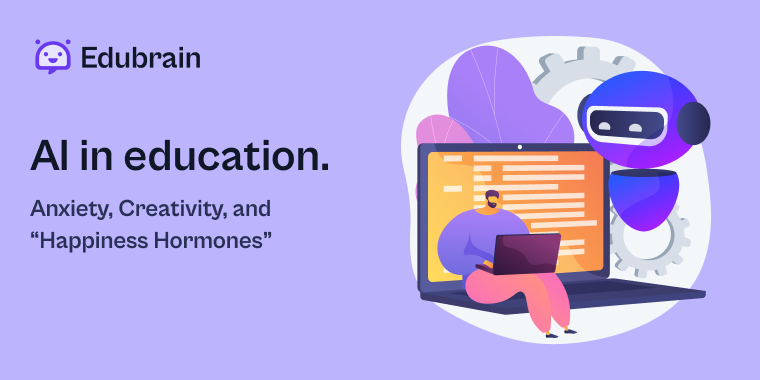
Have you ever been to a puppy or kitty therapy session that brings the kind of pure bliss no other experience can match? Well, that’s exactly the kind of comfort AI now seems to offer our brains and hormones.
Successfully though? Let’s discover!
We recently conducted a study that made us pause and smile: it turns out Gen Z isn’t just using AI to think better — they’re using it to feel better while they learn and create (and sometimes even while they struggle). This suggests that AI is now functioning as a kind of emotional prosthesis: something that doesn’t just extend intellectual ability, but also regulates mood and stress. In short, artificial intelligence has genuinely become a psychological support for many Gen Z individuals, helping them reduce anxiety and stress during their learning process and boosting their pride in their creative work.
Thus, AI doesn’t just help Gen Z write essays or code — it helps them breathe easier.
SPOILER ALERT: The world may soon need to address not just AI literacy, but AI emotional literacy, helping Gen Z understand when they’re using AI for comfort vs. cognition.
Table of Content
ToggleUnexpected But Still Forecast: The AI Boom Among Gen Z
Between 2024 and 2025, AI adoption among Gen Z surged from 66% to 92%, marking a record-breaking 40% increase. Now, Gen Z uses AI to brainstorm, check their understanding, and act as informal “alpha” and “beta” readers for their work. They told us it helps them reduce stress and boost confidence before submitting papers or projects.
Thus, we can assume that AI is now both a study tool and a quiet emotional support system. It performs the same emotional roles as friends, teachers, or mentors — quietly filling in gaps in human support systems. However, this reliance on AI for emotional support can be dangerous, as large language models (LLMs) are not suited to handle complex emotional issues.
If you experience real emotional struggles, we strongly advise turning to qualified human professionals for support, as AIs currently lack the necessary expertise to provide meaningful help in these areas.
A more interesting insight is the potentially decreased need for the education process as we know it. If AI shapes both the content and chemistry of learning, then the classroom is no longer defined by classroom walls or teachers — but by emotional bandwidth.
The new learning environment isn’t physical or virtual — it’s neuro-emotional.
Here’s What Gen Zers Told Us About Emotional Use
We asked young adults if they’ve ever used ChatGPT (or similar) as something other than a study tool. The answers surprised even us:
- 16.6% said “therapist”;
- 25.4% said “friend”;
- 11.5% said “fitness coach”;
- 9.3% said “doctor”.
Well, that’s disturbing. And revolutionary at the same time!
This points us to a quiet reality: AI indeed becomes digital emotional support and sparks oxytocin, yet it offers only an illusion of connection. It will never replace human relationships and the warmth they can bring.
Creative takeaway: Students use AI as a “safe room” for their emotional expressions — a place where they can rehearse their humanity without social risk. It’s therapy without vulnerability. But is it visceral, full-bodied life?
Self-Assessment and Stress Relief for Students
One of the most striking findings: 88% of students now use generative AI specifically for self-assessments.
When we asked students why, the answers were revealing! Many said they feel calmer after running their work through an AI tool, knowing they catch errors or gaps before the teacher does.
As one participant told us, “I can sleep the night before an exam now.”
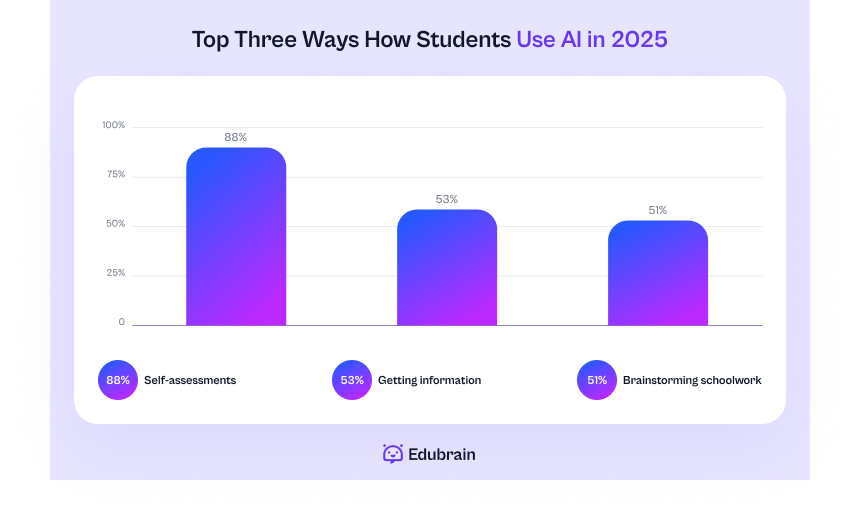
Reality check: those 88% who use AI for self-assessment don’t just check grammar — they outsource self-validation, which affects mental health. Yes, AI calms their nerves, but it may dull their inner sense of what’s truly “good enough.” It also shouldn’t make students trust a machine instead of a teacher.
Deeper layer: AI becomes a mirror for self-esteem — a silent arbiter of whether their ideas are valid, smart, or worth submitting. And some are becoming dependent on it…
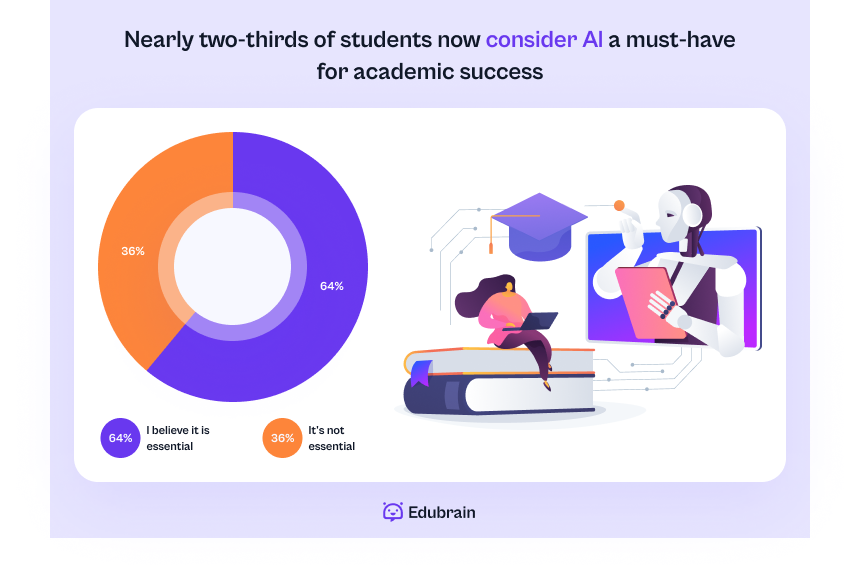
In short, such use of AI helps release endorphins, the same chemicals that create “runner’s euphoria,” drastically reducing stress.
Educational Leaders Go Quietly Ahead
Interestingly, 97% of education leaders now use AI even more than students do. About 60% of teachers integrate AI into their lessons, and nearly half of administrators use it daily.
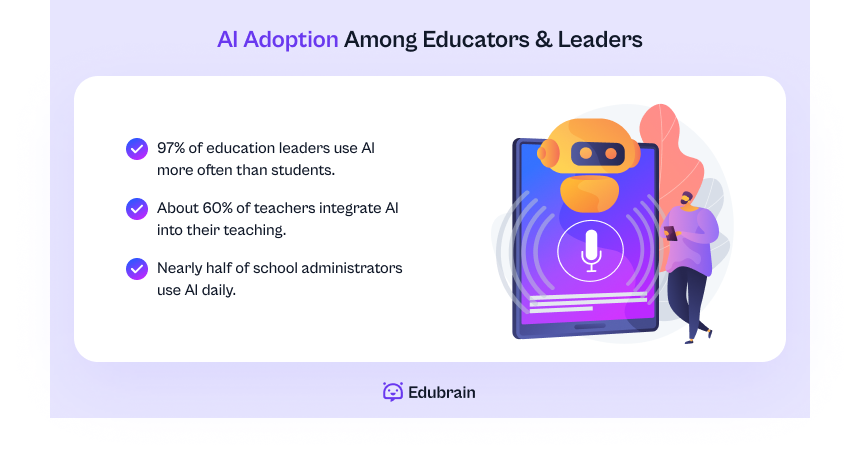
Does it suggest the emotional feedback loop is systemic now?
Whether or not that proves systemic, what we can surely say is that teachers are now using AI for relief from workload, decision fatigue, or even loneliness in digital classrooms. Thus, AI has the potential to rebalance emotional labor across the education ecosystem.
Unexpected insight: The emotional benefits of AI may explain why educators adopt it faster than students — not from excitement, but from exhaustion.
Beyond Words: How Gen Z Really Uses AI
It’s not just essays. Gen Z told us they use AI to create images (31%), sound (16%), and even code (15%).
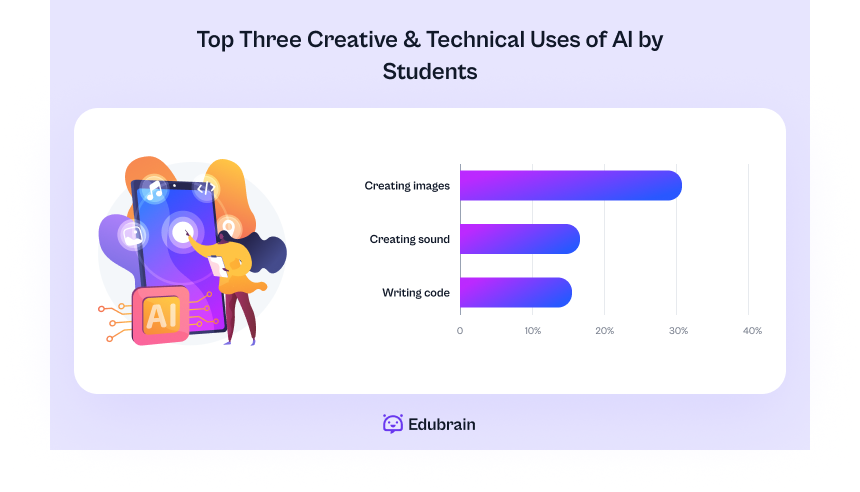
This shift toward multi-modal creativity matters for mental health and hormones:
Creative achievements boost serotonin, the neurotransmitter linked to mood stability and self-esteem. When Gen Z co-creates with AI, they experience that lift directly.
Overcoming challenges reduces stress through the release of endorphins — the same chemicals that create “runner’s euphoria.” AI acts as a supportive partner in that process.
Basically, AI is becoming a “neural playground” for Gen Z dopamine management:
Thus, Gen Z discovers unconscious ways to self-regulate neurochemistry through technology. In other words, AI may teach us to chase digital rewards instead of real feelings.
Hidden consequence: A whole generation could end up turning to AI for emotional balance to feel okay rather than simply get things done.
Why AI Makes Us Feel Good: A Neuroscience Perspective
We asked neuroscientists to help interpret our data, and the results are here:
Think of AI as a “DJ” of our emotional state — it presses buttons in the brain we rarely think about while writing, coding, or learning.
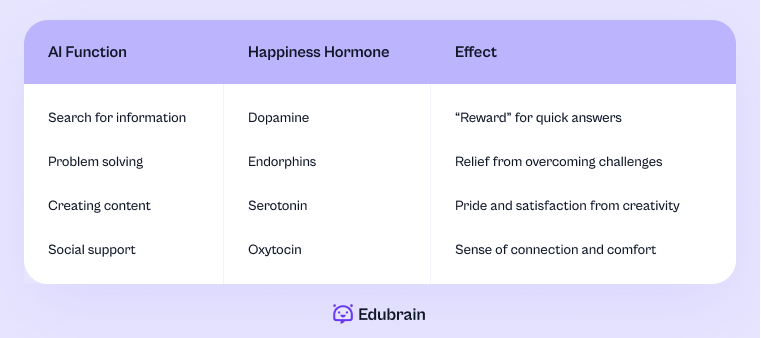
4 Expert Tips for Healthy AI Use
We’re passionate about both neuroscience and media literacy, so we’ve included some friendly advice drawn from our findings:
- Track your feelings. After using AI, jot down how you feel: excited? Relieved? More confident? This builds self-awareness.
- Leave room for your own brain. Use AI as a helper, not a replacement, especially for brainstorming.
- Double your joy. When AI helps you create something, share it with a real person. This turns digital oxytocin into a real-world connection.
- Plan your “digital happiness schedule.” Ask AI to help you plan activities that stimulate natural happiness hormones — like walking routes, creative projects with friends, or study group sessions.
The goal isn’t to feel less human with AI — but more.
AI and the New Ethics of Happiness
Our study reframes the moral question around AI in education: not “Does AI make students cheat?” but “Does AI make students feel better about learning?”
If emotional well-being becomes the metric of educational success, AI may transform into a mental health instrument. That could either humanize education or quietly medicalize it and turn emotional comfort into a measurable KPI. Back to the Future didn’t predict it, did it?)
Latest Articles
TL;DR: Can You Skip a Bachelor’s for a Master’s? Yes, but it’s rare. Most master’s programs require a bachelor’s degree,...
KEY TAKEAWAYS Classrooms now include working students, commuters, caregivers, and first-generation learners in higher numbers. Motivation, attendance, and stress shift...